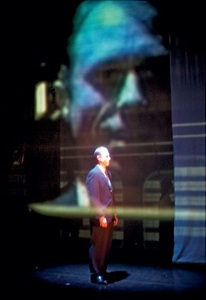Bruce Norris’s first play at the Court, The Pain and the Itch, skewered the pompous self-dramatisations of the upper-middle classes. Clybourne Park,
his second, concerns itself with race. Actually, it’s really more about
the pompous self-dramatisations of the upper-middle classes because
it’s less about race as such as about the contortions the white middle
classes go through to avoid appearing racist.
The play begins in the late 1950s in the hinterland of Lorraine Hansberry's A Raisin in the Sun. A
liberal couple are moving out of their home and it transpires that a
black family has bought it. The head of the local community association
comes round to persuade them not to let the sale go through. All this in
front of the family’s black maid and her husband. The second act is set
in the present in the same house. It is now run down and we are to
understand that the demographic of the neighborhood changed after that
house sale; black families took over, the area became less wealthy,
drugs and crime took hold. Now a young white couple are planning to buy
it and rebuild it. But there’s a problem; the local black community
association object to the plans and wish to preserve the historic
character of the area, with its particular importance for black history.
A good natured meeting becomes embroiled in accusations of racism and
ends in disarray.
It’s a funny play and becomes very funny
in the last third when the characters start telling each other
offensive jokes to debate the nature of racism and offence. The sense of
taboo-breaking, but also the genuine complexity of the rights and
wrongs, make this a somewhat hysterical scene in both senses. It’s
helped by some beautifully observed and lethally sharp dialogue.
There’s a touch of hollowness about the
play. First, the whole structure is designed, it seems, to allow a
debate to unfold; it’s not wholeheartedly worked through in dramatic
terms. It reminds me of Doug Lucie - in a good and bad way - thinking of The Green Man, which placed its characters in a pub so they could spar off each other but nothing much would really happen. The first half is more elegant, but a bit over-neatly carpentered (would the family really have no idea who’s buying their house?).
Second, there is a subplot about the
1950s couple’s son who killed himself after serving in Korea. His trunk
is buried in the garden as the couple leave the house and dug up again
in the second half. This goes absolutely nowhere and seems to be there
to provide a - slightly meretricious - emotional depth to the play,
which really wants to get into the debate and make some noise.
Third, it was funny but I was a little
uncomfortable with the laughter. It’s easy to slip from laughing at
someone’s mistaken decision to tell a somewhat racist joke into laughing
at the racist joke. I felt there was laughter around me that was
enjoying the racist joke and enjoying the thought that they were allowed
to laugh at it. The black guy sat next to me didn’t laugh much during
the play. (UPDATE: Afua Hirsch has discussed this point further in The
Guardian, and you can read it here.)
Fourth, though this is less to the
play’s discredit than the theatre’s, it is a tremendously old-fashioned
and middle-class play. A beautiful box-set on an angle, with anterooms
and stairs and outside space, it looks very West End. There’s even a
theatre curtain (when did the Court last have a theatre curtain?) But
hey, nothing wrong with all that in itself and Dominic Cooke always said
he wanted to reflect on the middle classes. But it does somehow make
the play feel constrained by its own form. Ultimately, it reduces things
to character and individuals; this is perhaps why I feel it’s not
actually a play about race; it’s a satirical portrait of some particular
people who have a recognisable discomfort with discussing race. Race
itself, its structural, institutional, global dynamics, isn’t something
the play can talk about.
So, I guess I’m saying I really enjoyed the play, thought it was extraordinarily funny, but ultimately it felt a little thin. This is more me than you because does everyone go to the theatre looking for masterpieces? I doubt it. In this instance, too, we should say there are some tremendous performances, most particularly from Martin Freeman in the second half who handles the language like a dream and captures perfectly the aggrieved bourgeois blundering through racism debates with a mixture of goodwill and impatience.


![photo[1].jpg](https://images.squarespace-cdn.com/content/v1/513c543ce4b0abff73bc0a82/1362919072201-PZO854G4SEB794DVOEI8/photo%5B1%5D.jpg)
